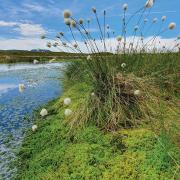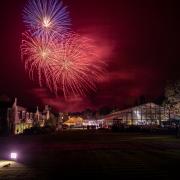Although you might think winter is the time of hibernation and sleep, much of our wildlife is as bustlingly busy as before. Finches and winter thrushes often form flocks during the winter to look for and improve their chances of finding food.
Spending time outdoors is also fantastic for mental health and wellbeing, whether you’re taking a short ramble around your local park or going on a full-length hike. It feels like common sense but there is scientific evidence of the benefits too. When we go outdoors and embrace our natural surroundings our bodies produce less of our stress hormone, cortisol, lowering our heart rate and blood pressure. We also produce more of our happy brain chemicals, dopamine and serotonin, increasing our sense of calm. And at this time of year, we need light at every opportunity.
Perhaps you’ve resolved to enjoy more of Yorkshire’s unique wildlife this January, or maybe you’re aching for a winter walk with a difference. Dress warmly, grab a flask and a torch, bring your family and friends – and enjoy Yorkshire Wildlife Trust’s list of wild spectacles.
Starling murmurations
You find yourself out on a walk as winter dusk sets on when without warning, calm skies are suddenly filled with a whirling, liquid-like mass of birds, moving in stunning synchronicity. This is a starling murmuration, one of nature’s awe-inspiring spectacles and still shrouded in a little mystery. Roosts usually begin to form in November, and last until early January. More and more birds will flock together as the weeks go on, and the number of starlings in a roost can swell to around 100,000 in some places. They’re a cacophonous experience, leaving flattened reedbeds in their wake – but truly something special.
Yorkshire Wildlife Trust have a number of fantastic reserves to watch murmurations from. Ripon City Wetlands beside the racecourse is best known for its incredible murmurations just before dusk, but Staveley nature reserve nearby, as well as North Cave Wetlands near Hull and Potteric Carr in Doncaster, have also been known to host these beautiful, swirling masses.
If you want to know more about starling murmurations and how to enjoy them, explore our webpage at: Starling murmurations | Yorkshire Wildlife Trust (ywt.org.uk)

Seal watching
Here in Yorkshire, we're lucky enough to be able to spot both grey seals and common seals up and down our coastline, bobbing around in the sea or resting on our beaches. The pupping season can begin from as early as mid-September and lasts through to January depending on the colony and location. Their curious nature and cuddly appearance makes seals bewitching to watch, and winter is the perfect time to observe them as mothers and pups bask on beaches, sand banks and rocky outcrops.
When done correctly and respectfully, seal-watching is a magical experience. Do not approach seal colonies, and instead watch from a good distance – preferably up on the clifftop. Never get between a seal and its pup, or a seal and the sea. If you have a dog, it must be kept on a lead and away from the seals at all times, and try to keep as quiet as you can. Disturbing seals can have tragic consequences for the pup, and disturbances use up energy reserves the seals are holding onto for other vital activities such as swimming, hunting, resting, digesting food, and hauling themselves out of the water.
Spurn National Nature Reserve is a great place to safely seal-watch, as grey seals can be spotted all the way down to the Point either resting on the beaches or bobbing in the water. You can also spot them from the cliffs at Flamborough Head nature reserve, and down much of the Yorkshire coast.

Drumming woodpeckers
Wander through a woodland in late winter or early spring and you’re likely to hear bursts of rapid, resonant tapping echoing through the trees. This staccato sound is the work of a woodpecker on a mission. Each rattle sends a message to all the other woodpeckers that can hear it – this part of the forest belongs to me.
Whilst some birds sing to attract a mate and intimidate their neighbours, woodpeckers take a different approach. They hammer their beak against a tree trunk at incredibly high speeds – up to 40 strikes per second for the great spotted woodpecker. When a bird finds a branch it likes, it may come back to drum against it again and again. It’s not just trees that attract them – they’ll sometimes use man-made structures, including metal poles.
There are three species of woodpecker that nest in Britain, but you are mostly likely to hear the great spotted woodpecker - our most common species, found in many woodlands and parks. Great spotted woodpeckers are glossy black and white birds with a splash of red beneath their tail – males also have a red patch on their nape. Their drumming is a short, explosive burst of strikes that last less than a second.
Find them at: Hollinhurst Wood, Adel Dam and Birch Wood nature reserves.
Diary date:
Wild Winter Festival, Potteric Carr nature reserve
February 3-17
Looking for a wild experience with a difference? Potteric Carr hosts some special seasonal events to keep the wonder of winter alive. This festival will include walks, talks, a mini mammal mosey, a campfire and so much more - so you can discover more about the magic of wildlife this winter. Sign up to join on our website.
Join as a member this year and help Yorkshire Wildlife Trust care for over 100 nature reserves – creating wilder havens for wildlife and people to enjoy.ywt.org.uk/membership



























